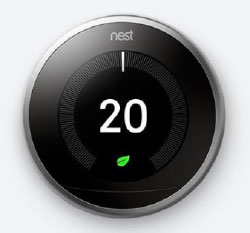Smart central heating systems are part of an emerging tech trend that is taking the world by storm. While HIVE may be one of the higher-profile brands in this fledgling market, it is not the only option for those looking to modernise the way in which they heat their home. Here are just a few of the alternatives.
Now in its third generation, this thermostat lives up to its name by learning the heating habits of its users and eventually gaining enough information to automatically adjust its own settings without the need for constant adjustment.
As with all good smart heating solutions, it can be controlled remotely via an internet connection, meaning you can interact with it even if you are on the other side of the world; however, as it is so sensitive to  changes, its auto-away feature will kick in when it works out that no one is in, saving you money on energy bills in addition to saving you time.
changes, its auto-away feature will kick in when it works out that no one is in, saving you money on energy bills in addition to saving you time.
While some smart thermostats opt for a minimalistic approach to displaying information, the IT500 from Salus is endowed with a large display that shows you all you need to know in a clear, unambiguous way. It allows for wireless control via a PC, smartphone or tablet, while drawing as little power as possible to keep its operations efficient.
One reason to pick this slightly more affordable heating system over its rivals is that it has been designed with integrated weather assessment capabilities; for example, if a cold snap or heat wave are forecast, it can take action to adjust your heating accordingly rather than leaving you freezing or boiling.
This is one of the most stylish internet-enabled thermostats on the market, with its appealing design allowing it to fit flawlessly into any modern home.
In addition to allowing users to control their central heating, it can also mange hot water settings, with all the remote control options you would expect. Up to eight different devices can be used to manage this thermostat, making it ideal for large families or properties shared by multiple tenants.
As with the IT500 from Salus, the Wave is capable of keeping tabs on the expected weather, ensuring that it does not turn the heating on unnecessarily when temperatures creep upwards. This is one of the main benefits of moving to a smart meter - you will never end up wasting energy and the initial cost of purchase will be absorbed over time by the savings you make.
The ease of installation of this particular smart thermostat is worthy of note, as it should be simple to set up in your home - an important aspect of making it accessible and useful to a wide audience.
There is no need to simply opt for HIVE hardware when there are so many other viable options around.



Add new comment